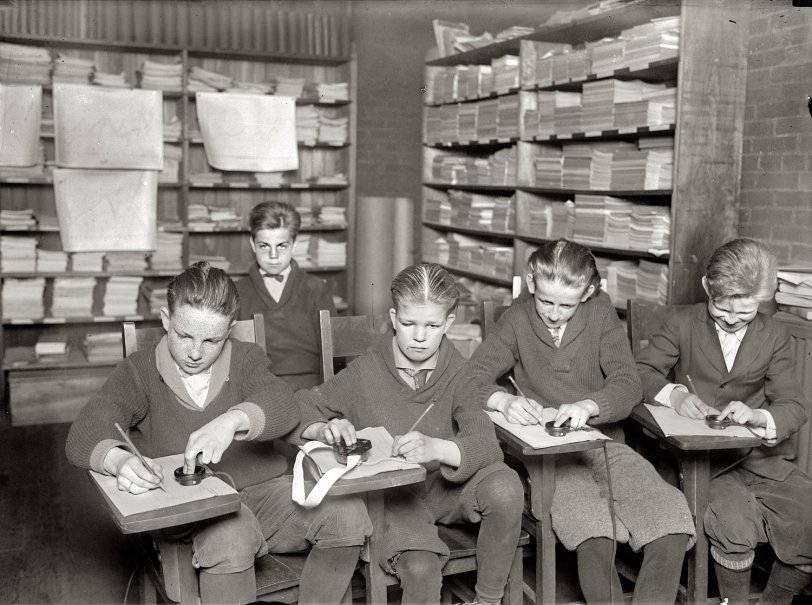


Framed or unframed, desk size to sofa size, printed by us in Arizona and Alabama since 2007. Explore now.
Shorpy is funded by you. Patreon contributors get an ad-free experience.
Learn more.

- Baldwin 62303
- Baldwin VO-1000
- Cold
- No expense spared
- Tough Guys
- Lost in Toyland
- And without gloves
- If I were a blindfolded time traveler
- Smoke Consumer Also Cooks
- Oh that stove!
- Possibly still there?
- What?!?
- $100 Reward
- Freeze Frame
- Texas Flyer wanted
- Just a Year Too Soon
- WWII -- Replacing men with women at the railroad crossing.
- Yes, Icing
- You kids drive me nuts!
- NOT An Easy Job
- I wonder
- Just add window boxes
- Icing Platform?
- Indiana Harbor Belt abides
- Freezing haze
- Corrections (for those who care)
- C&NW at Nelson
- Fallen Flags
- A dangerous job made worse
- Water Stop
Print Emporium
The Experiment: 1925

Washington, April 2, 1925. "Experiment at Gallaudet College by Professor R.H. Gault." View full size. National Photo Company Collection glass negative.
Sensitive Fingers
Washington Post, Mar 14,1926
Deaf Are Taught to Catch Sounds Through Fingers
R.H. Gault Finds that Skin is
Sensitive to Waves of VoiceIn a laboratory at Kendall Green experiments are being conducted by which it is hoped to enable the deaf to understand what is said to them by feeling the words with their fingers. This method is being perfected by Prof. Robert H. Gault, a professor of psychology at Northwestern university, now on leave of absence and working with the National Research Council here.
Prof. Gault has been working out this idea for several years. His first apparatus was a speaking tube between two rooms, his subject a person of normal hearing. It was found that the subject could distinguish notes of high and low pitch when they were shrieked against his hand. The next step was to teach him the "feel" of six different words, pronounced in a normal tone, in order. Then the words were spoken haphazard and the subject "felt" them correctly.
The waves of air, says Prof. Gault, which produce tonal sensations in the ear also produce sensations in the finger tips. A further instance of this, he said, was that on one occasion when some one was reading aloud in a heavy chair, he could feel the chair quivering with the vibrations.
...
The mechanism involved in these experiments is simple. The speaking tube, with which the work originated, has been replaced by a small electrical apparatus not unlike the telephone. The subject holds the receiver in his hand. Prof. Gault will continue his work here until October 1 and perhaps longer.
Richard Brill
A great friend and sailing buddy of mine was the late Dr Richard Brill. About the time this photo was taken Dick's parents were teachers at Gallaudet and he may have been about the same age as these boys. During the Depression he became a teacher of the deaf at Gallaudet (as a hedge against poverty) and, following Navy service in WWII, would go on to become the superintendent of the California School for the Deaf.
Lefty
I feel for that left-handed kid. Those right handed desks are a nuisance for a left-hander.
Tactile Vocoder
Gault apparently did some important early research in communication devices for the deaf.
The possibility of using vibration as a means of communication was explored by Gault and Knudsen. This early research focused on the use of single-channel devices without any preprocessing to take the characteristics of speech into account.
Single-channel tactile aids have since found a very useful practical application as alerting systems for deaf people. These devices fall under the category of nonspeech-specific tactile aids (column 3, row 1 of Table 1). ...
A tactile aid that takes the spectrum of speech into account is the tactile vocoder. An early vocoder of this type was developed by Gault and Crane, in which each of the fingers was stimulated tactually by a separate vibrator that, in turn, was driven by the speech power in a different region of the frequency spectrum.
























On Shorpy:
Today’s Top 5